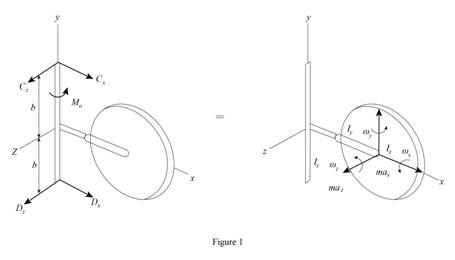
Concept explainers
The dynamic reaction at C and D after the couple has been removed.
Answer to Problem 18.101P
The dynamic reaction at C after the couple has been removed is
The dynamic reaction at D after the couple has been removed is
Explanation of Solution
Given information:
The weight (W) of the disk is 6 lb.
The radius (r) of the disk is 3 in..
The angular velocity
The angular velocity of shaft CBD and arm AB is
The horizontal distance (c) between the center of rod CBD and center of disk is 5 in..
The vertical distance (b) between the center of rod CBD and center of disk is 4 in..
The couple
The time (t) of couple applied is 2 s.
Calculation:
Find the mass (m) of the disk using the equation:
Here, g is the acceleration due to gravity.
Substitute 6 lb for W and
Write the equation of vector form of angular velocity
The angular velocity
Write the equation of angular velocity of disk A
Write the equation of angular velocity
Find the equation of angular velocity
Substitute 0 for
Find the equation of angular momentum about A
Substitute 0 for
Find the rate of change of angular momentum
Here,
Write the equation of the rate of change of angular momentum about A
Substitute
Write the equation mass moment of inertia
Write the equation mass moment of inertia
Write the equation of velocity of the mass center A of the disk.
Write the equation of acceleration of the mass center A of the disk.
Substitute
Find the position vector of D with respect to A.
Substitute 5 in. for c and 4 in. for b.
Find the rate of change of angular momentum about D
Substitute
Substitute
Sketch the free body diagram and kinetic diagram of the system as shown in Figure (1).

Refer Figure (1).
Apply Newton’s law of motion.
Substitute
Equate i-vector coefficients in Equation (3).
Equate k-vector coefficients in Equation (3).
Take moment about D.
Here,
The moment at D is equal to the rate of change of angular momentum at D.
Equate Equation (3) and (7).
Find the acceleration of shaft CBD and arm using equate the j- vector coefficients in Equation (8).
Substitute
After the 2 s, the couple
Find the angular velocity
Substitute 0 for
Find the component of dynamic reaction at C
Substitute 4 in. for b, 3 in. for r, 5 in. for c, and
Find the component of dynamic reaction at D
Substitute 4 in. for b, 3 in. for r, 5 in. for c, 14.18 rad/s for
Find the component of dynamic reaction at C
Substitute 4 in. for b, 3 in. for r, 60 rad/s for
Find the component of dynamic reaction at D
Substitute 4 in. for b, 3 in. for r, 60 rad/s for
Find the dynamic reactions at C using the equation:
Substitute
Thus, the dynamic reactions at C after the couple has been removed is
Find the dynamic reactions at D using the equation:
Substitute
Thus, the dynamic reactions at D after the couple has been removed is
Want to see more full solutions like this?
Chapter 18 Solutions
Connect 1 Semester Access Card for Vector Mechanics for Engineers: Statics and Dynamics
- (Read Question)arrow_forwardIn figure A, the homogeneous rod of constant cross section is attached to unyielding supports. In figure B, a homogeneous bar with a cross-sectional area of 600 mm2 is attached to rigid supports. The bar carries the axial loads P1 = 20 kN and P2 = 60 kN, as shown.1. In figure A, derive the expression that calculates the reaction R1 in terms of P, and the given dimensions.2. In figure B, calculate the reaction (kN) at A.3. In figure B, calculate the maximum axial stress (MPa) in the rod.arrow_forward(Read image)arrow_forward
- (Read Image)arrow_forwardM16x2 grade 8.8 bolts No. 25 C1- Q.2. The figure is a cross section of a grade 25 cast-iron pressure vessel. A total of N, M16x2.0 grade 8.8 bolts are to be used to resist a separating force of 160 kN. (a) Determine ks, km, and C. (b) Find the number of bolts required for a load factor of 2 where the bolts may be reused when the joint 19 mm is taken apart. (c) with the number of bolts obtained in (b), determine the realized load factor for overload, the yielding factor of safety, and the separation factor of safety. 19 mmarrow_forwardProblem4. The thin uniform disk of mass m = 1-kg and radius R = 0.1m spins about the bent shaft OG with the angular speed w2 = 20 rad/s. At the same time, the shaft rotates about the z-axis with the angular speed 001 = 10 rad/s. The angle between the bent portion of the shaft and the z-axis is ẞ = 35°. The mass of the shaft is negligible compared to the mass of the disk. a. Find the angular momentum of the disk with respect to point G, based on the axis orientation as shown. Include an MVD in your solution. b. Find the angular momentum of the disk with respect to point O, based on the axis orientation as shown. (Note: O is NOT the center of fixed-point rotation.) c. Find the kinetic energy of the assembly. z R R 002 2R x Answer: H = -0.046ĵ-0.040 kg-m²/sec Ho=-0.146-0.015 kg-m²/sec T 0.518 N-m =arrow_forward
- Problem 3. The assembly shown consists of a solid sphere of mass m and the uniform slender rod of the same mass, both of which are welded to the shaft. The assembly is rotating with angular velocity w at a particular moment. Find the angular momentum with respect to point O, in terms of the axes shown. Answer: Ñ。 = ½mc²wcosßsinßĵ + (}{mr²w + 2mb²w + ½ mc²wcos²ß) k 3 m r b 2 C لا marrow_forwardOnly question 2arrow_forwardOnly question 1arrow_forward
- Only question 3arrow_forwardI have Euler parameters that describe the orientation of N relative to Q, e = -0.7071*n3, e4 = 0.7071. I have Euler parameters that describe the orientation of U relative to N, e = -1/sqrt(3)*n1, e4 = sqrt(2/3). After using euler parameter rule of successive rotations, I get euler parameters that describe the orientation of U relative to Q, e = -0.4082*n1 - 0.4082*n2 - 0.5774*n3. I need euler parameters that describe the orientation of U relative to Q in vector basis of q instead of n. How do I get that?arrow_forwardDescribe at least 4 processes in engineering where control charts are (or should be) appliedarrow_forward
 Elements Of ElectromagneticsMechanical EngineeringISBN:9780190698614Author:Sadiku, Matthew N. O.Publisher:Oxford University Press
Elements Of ElectromagneticsMechanical EngineeringISBN:9780190698614Author:Sadiku, Matthew N. O.Publisher:Oxford University Press Mechanics of Materials (10th Edition)Mechanical EngineeringISBN:9780134319650Author:Russell C. HibbelerPublisher:PEARSON
Mechanics of Materials (10th Edition)Mechanical EngineeringISBN:9780134319650Author:Russell C. HibbelerPublisher:PEARSON Thermodynamics: An Engineering ApproachMechanical EngineeringISBN:9781259822674Author:Yunus A. Cengel Dr., Michael A. BolesPublisher:McGraw-Hill Education
Thermodynamics: An Engineering ApproachMechanical EngineeringISBN:9781259822674Author:Yunus A. Cengel Dr., Michael A. BolesPublisher:McGraw-Hill Education Control Systems EngineeringMechanical EngineeringISBN:9781118170519Author:Norman S. NisePublisher:WILEY
Control Systems EngineeringMechanical EngineeringISBN:9781118170519Author:Norman S. NisePublisher:WILEY Mechanics of Materials (MindTap Course List)Mechanical EngineeringISBN:9781337093347Author:Barry J. Goodno, James M. GerePublisher:Cengage Learning
Mechanics of Materials (MindTap Course List)Mechanical EngineeringISBN:9781337093347Author:Barry J. Goodno, James M. GerePublisher:Cengage Learning Engineering Mechanics: StaticsMechanical EngineeringISBN:9781118807330Author:James L. Meriam, L. G. Kraige, J. N. BoltonPublisher:WILEY
Engineering Mechanics: StaticsMechanical EngineeringISBN:9781118807330Author:James L. Meriam, L. G. Kraige, J. N. BoltonPublisher:WILEY





